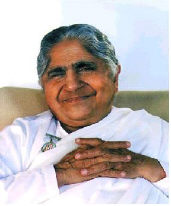라자요가 명상이란?

명상은 내면으로 떠나는 여행이며, 자신을 재발견하는 여정이다. 명상은 바쁜 일상에서 벗어나, 고요한 사색과 침묵 속에 앉아서 내 존재의 중심으로 다시 돌아갈 수 있는 시간을 갖는 것이다. 현대인의 삶은 그 어느 때보다도 바쁘게 돌아가고 있고 그로 인해 우리는 우리의 내면의 평화와 힘을 경험할 시간을 갖지 못하고 있다. 안정되어 있지 못할 때, 우리의 의식은 여기저기로 분산되며 그 때부터 우리는 스트레스와 갑갑함을 느끼기 시작한다. 점점 시간이 지나면서 이러한 느낌들은 우리를 신체적, 감정적, 정신적으로 병들게 하여 균형을 잃게 만드는 원인이 된다.
라자요가 명상은 남녀노소 누구나 경험할 수 있는 명상법이다. 이 명상법은 특정한 의식이나 만트라 없이 언제 어디서나 할 수 있다. 라자요가 명상은 “눈을 뜨고” 명상을 하기 때문에 하루 중 언제나 수련할 수 있으며, 단순하고 쉬운 명상법이다. 명상은 일상적인 의식을 넘어 존재의 상태에 머무는 연습이다. 이 영적인 의식은 우리에게 부정적이거나 낭비적인 생각 대신에 긍정적인 생각을 선택할 수 있는 힘을 준다. 그러면 우리는 상황에 대해 그저 반응하기보다는 적절하게 대처할 수 있게 된다. 그러면 우리는 좀 더 조화로운 삶을 살게 되며, 행복하고 건강한 대인 관계를 맺음으로써 긍정적인 방식으로 자기 삶을 변화시키게 된다.
어떻게 명상하는가?
라자요가 명상은 ‘쉬운 라자요가’라 불릴 정도로 쉬운 명상법이다. 그러나 시작을 하려면 설명이 필요하다. 여기에 라자요가 명상을 따라 할 수 있는 간단한 5 단계를 소개한다. 이 방법을 따라 하다 보면 머지 않아 생각 하나만으로 단번에 고요한 내면의 정적 속으로 들어갈 수 있다. 그 때쯤에는 이 다섯 단계조차 필요 없게 될 것이다.
라자요가 명상 경험을 위한 5 단계
1단계: 이완

이완은 긴장과 스트레스를 내려놓고 몸과 마음을 차분하고 평화롭게 만드는 것이다.
2단계: 집중

일단 이완이 되고 나면, 집중을 통해 시간을 생산적으로 사용할 수 있다. 나는 내가 선택한 생각에 초점을 맞춘다.
3단계: 성찰

성찰은 나 자신과 나의 내면 세계, 나의 가치관 등을 깊이 사색하는 것이다.
4단계: 깨달음

깨달음은 나의 이해와 느낌이 하나가 되어 더 심오하고, 의미 있는 내면의 현실을 경험하는 것이다.
5단계: 명상

명상은 한 가지 생각에 초점을 맞추고, 나의 영원한 정체성을 기억하며, 자기 내면에서 행복과 경이로움으로 가득한 기억을 일깨우는 것이다.
어떤 사람들이 라자요가를 하는가.
라자요가는 원하는 사람은 누구나 할 수 있고 혜택을 경험할 수 있다. 어떤 사람들은 브라마쿠마리스 명상센터에 정기적으로 와서 센터에 연결된 느낌을 확인하기도 하고, 어떤 사람들은 명상을 자신의 일상생활의 일부로 만들고, 또 다른 사람들은 자신의 영적 수련에 라자요가 명상을 접목시키기도 한다. 그 어떤 것이라도 도움이 되며, 그들의 삶이 풍요로워진다.

다음과 같은 사람들이 라자요가 명상에서 많은 혜택을 경험한다.
• 오래 동안 영적인 해결책을 찾아오다가 다른 어디에서도 찾을 수 없었던 것을 라자요가에서 발견하는 사람들
• 인생에서 많은 것을 성취하고 달성했는데, “이게 전부인가?”라는 생각이 드는 사람들
• 삶 속에서 어려움과 도전을 겪고 있어서 뭔가 가외의 도움을 필요로 하는 사람들
• 신성을 더 깊이 이해하고 신과의 연결을 경험하고 싶은 사람들
• 자기 자신의 에너지와 좋은 염원으로 세상에 평화를 가져오고, 자신이 발견한 행복과 충족감을 세상의 다른 영혼들과 나누고 싶은 사람들




